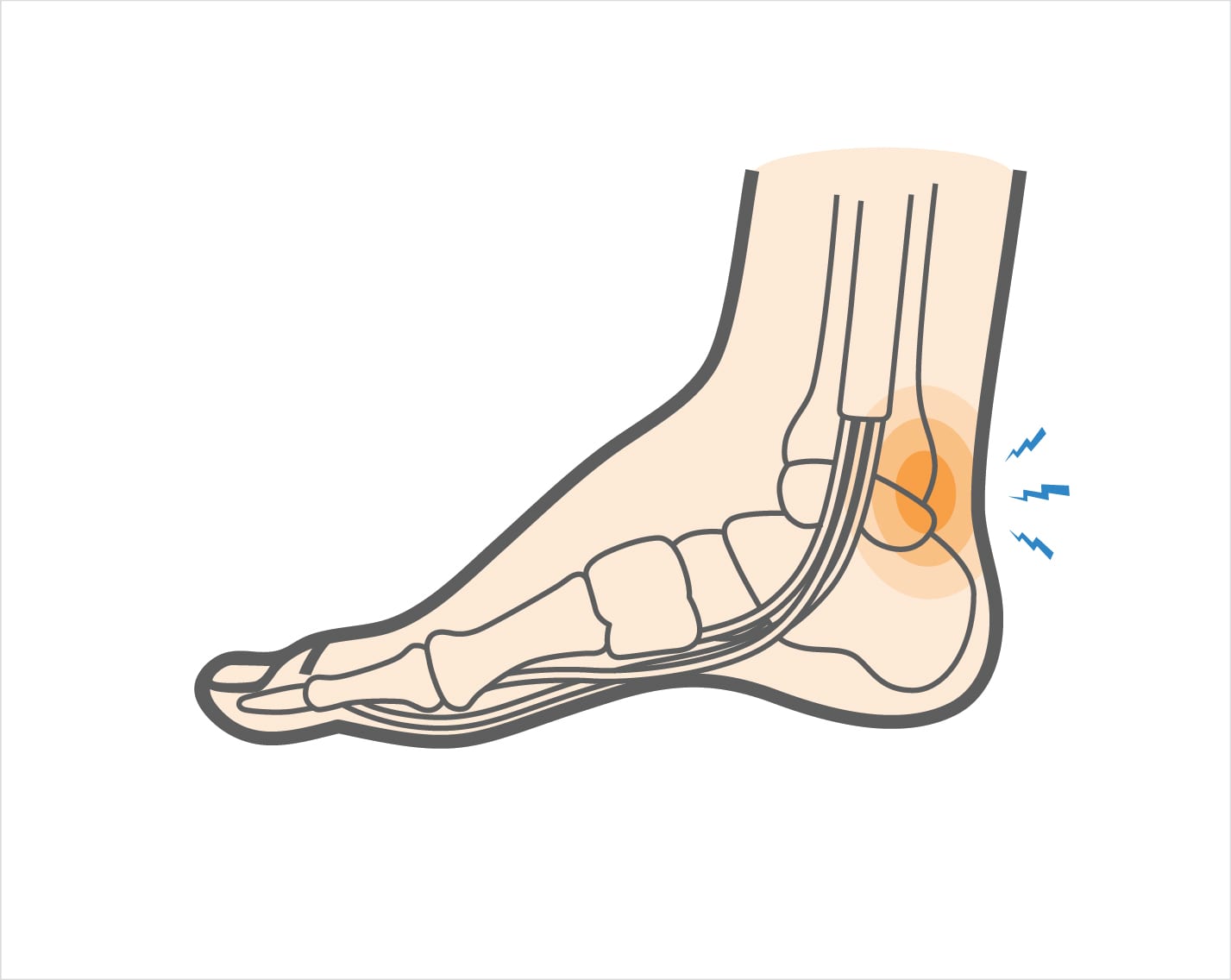Ankle Impingement (Posterior) Causes, Symptoms & Treatment
Posterior ankle impingement is commonly seen in athletes who engage in repetitive plantarflexion. It occurs when soft tissue or small bony structures at the back of the ankle become compressed, resulting in pain, swelling, and restricted movement. A thorough assessment and appropriate management, including conservative treatment and, in select cases, arthroscopic intervention, are essential for optimal recovery.
Start with our quick Symptom Assessment or connect directly with an Upswing Coach today.
Request an AppointmentReady to take the next step?
Start your symptom assessment or connect with a coach instantly.
Find Relief TodayOverview
Ankle impingement (posterior) is a condition that causes pain in the back of the ankle, particularly during movements that point the toes downward. It occurs when soft tissue or small bony structures between the shin bone (tibia) and heel bone (calcaneus) become compressed, leading to inflammation and discomfort.
In some cases, a small bone (os trigonum) or a bony projection (Stieda process) can create friction, and occasionally, tiny bone fragments may also become trapped, worsening the condition.
This condition is a type of ankle impingement, common in athletes who engage in sports that involve rapid acceleration, jumping, or extreme ankle movements, such as soccer, running, and ballet, and has historically been referred to as “athlete’s ankle” or “footballer’s ankle.”

What causes Ankle Impingement (Posterior)?
Posterior ankle impingement often develops due to chronic, repetitive strain on the ankle from sports or intense training. Movements involving repeated downward bending of the foot (plantarflexion) can aggravate the condition. It may also result from trauma that causes fractures of small bones at the back of the ankle joint.
- How the Injury Occurs: Repeated forced extension of the ankle during jumping, landing, or toe push-offs compresses soft tissues at the back of the joint, causing irritation and swelling.
- Common Everyday Causes: This can occur in non-athletes with repetitive ankle movements, such as dancers on hard floors, frequent squatters or kneelers, and workers maintaining plantarflexed positions for long durations.
Posterior ankle pain is most common in the following sports:
- Soccer: Repeated kicking and quick directional changes strain the ankle.
- Gymnastics: Continuous landings and pointed toe positions increase joint compression.
- Ballet/Dance: Often called “ballet dancer’s ankle” due to its frequency in this population.
- Basketball: Frequent jumping and abrupt stops stress the posterior ankle.
- Volleyball: Repetitive jumps and landings heighten pressure on the ankle joint.
Symptoms
Athletes with posterior ankle pain usually experience sharp pain in the back of the ankle during plantarflexion, especially when performing activities that require the ankle to bend downward. This pain is often noticeable when kicking, running downhill, or performing similar movements.
Common symptoms include:
- Pain that eases to a dull ache at rest
- Tenderness when touching the back of the ankle
- A sense of ankle instability
- Discomfort when wearing high heels
- Visible or palpable swelling at the back of the ankle
When to see a doctor
If you experience symptoms of posterior ankle impingement, it is important to consult a healthcare professional for a thorough evaluation.
The assessment typically involves discussing your injury history, current symptoms, and activity level.
An examination can help identify tenderness and swelling at the back of the ankle, while imaging studies such as X-rays or MRI scans can reveal bone abnormalities or other underlying causes.
Non-operative treatment
Management typically focuses on rest and avoiding activities that worsen symptoms, such as kicking, jumping, running downhill, or repetitive plantarflexion movements. Conservative treatment options include:
- Ice: Reduces swelling and pain after activity.
- Elevation: Keeps the leg raised to minimize inflammation.
- Compression: Supports the ankle and limits excessive movement.
- NSAIDs: Medications such as ibuprofen or naproxen relieve pain and inflammation.
- Corticosteroid injections: Used for significant inflammation or persistent pain.
- Ankle brace: Provides stability and protects against further injury.
- Physical therapy: Improves strength, flexibility, and restores normal ankle motion.
Try these exercises to help manage your condition:
Below is a PDF of the Exercise Program
Surgical Treatment
Surgery for posterior ankle impingement is generally reserved for severe cases that do not respond to conservative treatment. The procedure aims to remove bone or scar tissue causing compression and discomfort. Potential risks include excessive bone removal, which may lead to joint instability, or increased pain if motion is restored in an arthritic ankle.
Minimally invasive arthroscopic resection techniques are often preferred to reduce recovery time and tissue trauma. Decisions regarding surgery should be made in consultation with an orthopedic specialist, who can assess the severity of the condition and determine whether operative intervention is the most appropriate option.
Recovery
Recovery from posterior ankle impingement varies depending on the severity of the injury. Most athletes can return to normal activities within four to six weeks, although more severe cases may take longer.
A structured physical therapy program is essential to rebuild ankle strength, flexibility, and stability, supporting a safe and effective return to sports or daily activities.
Dr. Jay Kimmel is a board-certified orthopedic surgeon specializing in sports medicine, arthroscopic surgery, and shoulder and knee disorders. He completed his orthopedic training at New York-Presbyterian/Columbia University Medical Center and a Sports Medicine Fellowship at Temple University.
Dr. Kimmel previously served as the Director of the Connecticut Sports Medicine Institute at Saint Francis Hospital and has held faculty appointments as Clinical Assistant Professor in the Departments of Orthopedics and Family Medicine at the University of Connecticut. He has extensive experience caring for athletes as a team physician for high school and collegiate programs and continues to teach in the athletic training departments at Westfield State University and Springfield College.
Find the Support You Need — Right When You Need It
Whether you’re managing pain for the first time, need ongoing guidance, or require expert medical care, we’re here to help you every step of the way.
ORTHO DIRECT
Video visit with an orthopedic doctor for advice and a care plan.
$30
/MonthMRI DIRECT
Fast, affordable MRI with orthopedic review. No insurance required.
$499
/MonthFrequently Asked Questions
How can I recognize signs of posterior ankle impingement?
You may notice a sharp sensation at the back of the ankle during motion, primarily while pointing your foot downward. Swelling, tenderness, and a sense of tightness or restriction in movement may also be present.
What are the first steps to support healing from posterior ankle impingement?
Supportive steps include resting the ankle, using cold compresses, gentle compression, and elevation. Guided exercises and therapy can help restore strength and flexibility, keeping you active and confident in your movements.
Is professional care helpful for managing this condition?
Yes, a healthcare provider can offer personalized care through physical assessments and imaging to ensure your treatment plan aligns with your activity level and goals for recovery.
Can I return to sports or dance after treatment?
Absolutely. After a tailored recovery plan, many individuals return to their favorite activities with improved strength and comfort. With consistent care, mobility and performance can be successfully restored.

